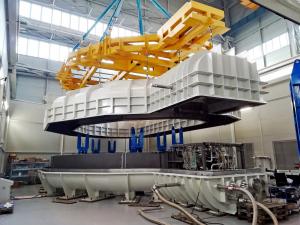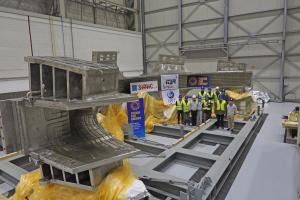First cold test in Europe
The first ITER toroidal field coil winding pack has spent nearly 20 days in a specially conceived cryostat at minus 193 °C (80 K), in a cold testing operation that confirmed the integrity of the insulation system.
The first toroidal field winding pack produced in Europe was shipped from its manufacturing location last November. Reception teams at SIMIC first performed a series of dimensional and electrical inspection tests, before lifting the component into a specially constructed cryostat, where the winding pack was cooled to 80 K (193 °C) for nearly 20 days using a combined cycle of nitrogen and helium. Electrical connections placed at the exits of the chamber were tested with a current of 1000 amps.
At SIMIC the cooling chamber, the specialized tooling and the laser measuring equipment took almost one year to assemble, explains the company's commercial manager Marianna Ginola. "... We have invested in the infrastructure of our plant, collaborated extensively with our subcontractors, and trained our workforces for the delicate operations that we will have to carry out." SIMIC is collaborating with subcontractor Babcock Noell GmbH for some of the tooling and technologies.



